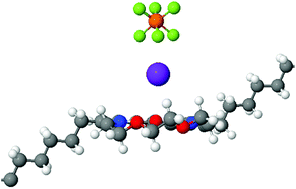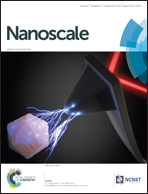Increasing the thermopower of crown-ether-bridged anthraquinones†
Abstract
We investigate strategies for increasing the thermopower of crown-ether-bridged anthraquinones. The novel design feature of these molecules is the presence of either (1) crown-ether or (2) diaza-crown-ether bridges attached to the side of the current-carrying anthraquinone wire. The crown-ether side groups selectively bind alkali-metal cations and when combined with TCNE or TTF dopants, provide a large phase-space for optimising thermoelectric properties. We find that the optimum combination of cations and dopants depends on the temperature range of interest. The thermopowers of both 1 and 2 are negative and at room temperature are optimised by binding with TTF alone, achieving thermpowers of −600 μV K−1 and −285 μV K−1 respectively. At much lower temperatures, which are relevant to cascade coolers, we find that for 1, a combination of TTF and Na+ yields a maximum thermopower of −710 μV K−1 at 70 K, whereas a combination of TTF and Li+ yields a maximum thermopower of −600 μV K−1 at 90 K. For 2, we find that TTF doping yields a maximum thermopower of −800 μV K−1 at 90 K, whereas at 50 K, the largest thermopower (of −600 μV K−1) is obtain by a combination TTF and K+ doping. At room temperature, we obtain power factors of 73 μW m−1 K−2 for 1 (in combination with TTF and Na+) and 90 μW m−1 K−2 for 2 (with TTF). These are higher or comparable with reported power factors of other organic materials.



 Please wait while we load your content...
Please wait while we load your content...